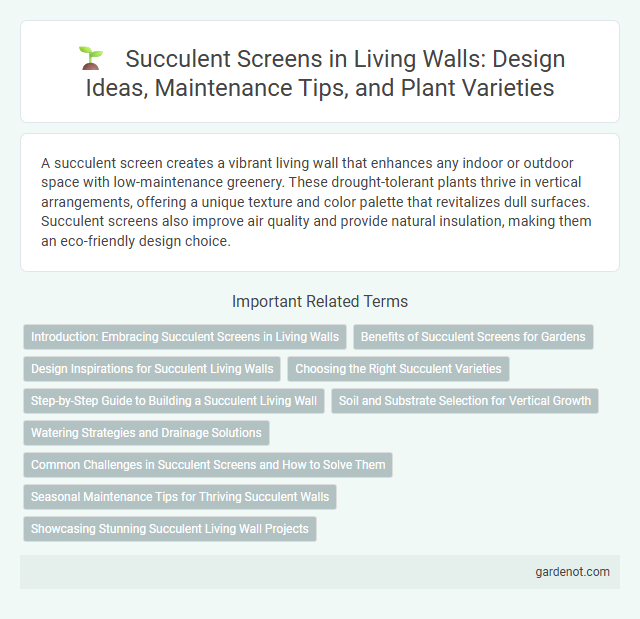A succulent screen creates a vibrant living wall that enhances any indoor or outdoor space with low-maintenance greenery. These drought-tolerant plants thrive in vertical arrangements, offering a unique texture and color palette that revitalizes dull surfaces. Succulent screens also improve air quality and provide natural insulation, making them an eco-friendly design choice.
Introduction: Embracing Succulent Screens in Living Walls
Succulent screens revolutionize living walls by offering drought-resistant greenery that thrives in various environments with minimal maintenance. These plants store water in their thick leaves, enabling vibrant vertical gardens even in arid conditions or low-light areas. Incorporating succulent screens enhances aesthetic appeal while promoting sustainable, eco-friendly landscaping solutions for indoor and outdoor spaces.
Benefits of Succulent Screens for Gardens
Succulent screens enhance garden aesthetics by creating vibrant, low-maintenance vertical displays that thrive in various climates. Their drought-resistant nature conserves water, promoting sustainable gardening practices while reducing irrigation needs. These living walls also improve air quality, provide natural insulation, and support urban biodiversity by attracting pollinators.
Design Inspirations for Succulent Living Walls
Succulent screens transform living walls by combining drought-resistant plants such as echeveria, sedum, and crassula into intricate, textured patterns that maximize visual appeal while minimizing water use. Designers draw inspiration from natural desert landscapes, geometric forms, and vibrant color palettes to create sustainable, eye-catching vertical gardens suitable for both indoor and outdoor environments. These succulent living walls offer low-maintenance biophilic solutions that enhance air quality and provide year-round greenery in urban spaces.
Choosing the Right Succulent Varieties
Selecting the right succulent varieties for a living wall ensures optimal growth and aesthetic appeal, with options like Echeveria, Sedum, and Crassula offering diverse textures and colors. Succulents with shallow root systems and drought tolerance, such as Haworthia and Aloe, adapt well to vertical planting environments and require minimal maintenance. Prioritizing succulents with complementary growth habits and sizes enhances the structural integrity and visual harmony of the succulent screen over time.
Step-by-Step Guide to Building a Succulent Living Wall
Creating a succulent living wall involves selecting a sturdy frame or grid to securely hold the plants and soil medium. Begin by attaching a waterproof backing to protect the surface, followed by layering a moisture-retentive substrate designed for succulents, ensuring proper drainage. Carefully plant a variety of drought-tolerant succulents, spacing them to allow growth, and maintain the wall with occasional watering and indirect sunlight to promote thriving, vibrant growth.
Soil and Substrate Selection for Vertical Growth
Selecting the right soil and substrate for a succulent screen is critical to ensure proper vertical growth and plant health. A well-draining substrate mix, often composed of cactus soil combined with perlite or pumice, facilitates aeration and prevents root rot in vertical garden installations. Optimal soil moisture balance and nutrient retention support the unique water storage capabilities of succulents while maintaining structural stability on living walls.
Watering Strategies and Drainage Solutions
Succulent screens require precise watering strategies to prevent over-saturation, typically involving infrequent but thorough watering to mimic their natural arid environment. Effective drainage solutions, such as well-designed drip irrigation systems combined with permeable substrates, ensure excess water is efficiently expelled to avoid root rot. Incorporating moisture sensors can optimize irrigation schedules, maintaining ideal hydration levels for healthy succulent growth on living walls.
Common Challenges in Succulent Screens and How to Solve Them
Succulent screens often face common challenges such as overwatering, inadequate sunlight, and pest infestations, which can lead to root rot and stunted growth. Ensuring well-draining soil and proper irrigation schedules, alongside positioning the screen in environments with ample, indirect sunlight, helps maintain plant health. Regular inspection for pests like aphids or mealybugs combined with organic treatments effectively prevents infestations and sustains the screen's vibrant appearance.
Seasonal Maintenance Tips for Thriving Succulent Walls
Succulent screens require minimal seasonal maintenance, including checking for proper drainage to prevent root rot during wetter months. Trim dead or yellowing leaves in early spring to encourage new growth and improve airflow. Ensure succulents receive adequate indirect sunlight and adjust watering frequency based on temperature fluctuations to maintain vibrant, healthy walls.
Showcasing Stunning Succulent Living Wall Projects
Succulent screens create vibrant, low-maintenance living walls that transform indoor and outdoor spaces with unique textures and colors. These stunning succulent living wall projects highlight drought-resistant plant varieties arranged in geometric patterns for maximum visual impact. Incorporating species such as echeveria, sedum, and crassula, succulent screens offer sustainable greenery solutions ideal for homes, offices, and urban environments.
Succulent screen Infographic

 gardenot.com
gardenot.com